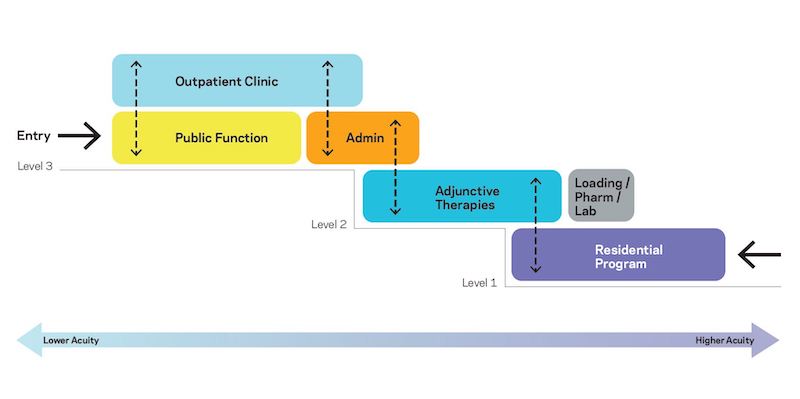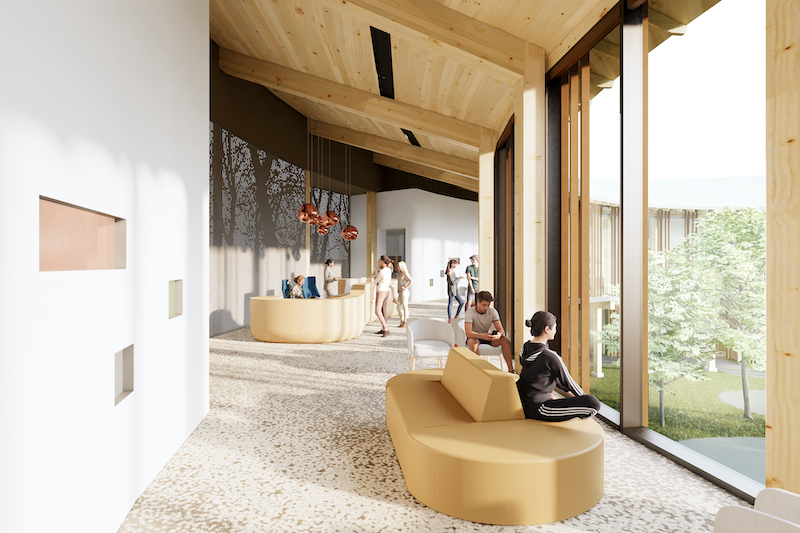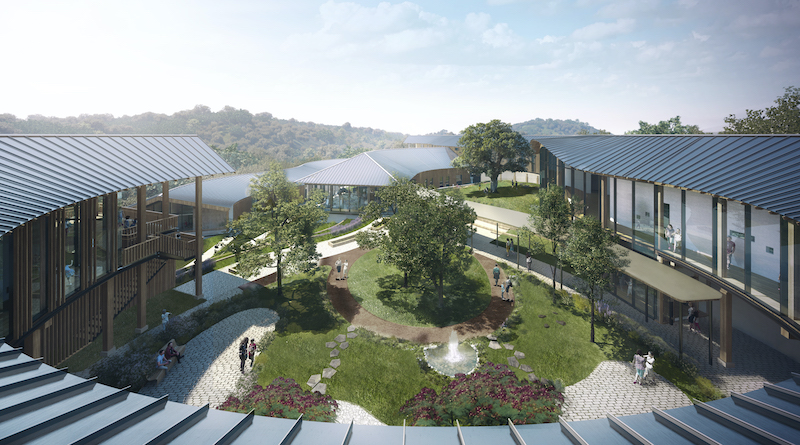A survey of 1,313 Americans ages 18 or older, which KFF Tracking conducted last July, found that more than half of those polled, 53%, reported their mental health had been negatively impacted by the coronavirus pandemic. Even before the virus started spreading, an estimated 26% of Americans suffered from diagnosable mental disorder in a given year, according to the National Institute of Mental Health Disorders.
The demand for healthcare facilities that offer mental and behavioral health services is increasing, and presents new design and construction opportunities to AEC firms.
About a year ago, on March 10, 2020, Nationwide Children’s Hospital debuted its nine-story $159 million Big Lots Behavioral Health Pavilion in Columbus, Ohio. The pavilion, designed by NBBJ and built by Turner Construction, opened as the largest pediatric facility for this specialty in the country. It has 48 inpatient beds, a psychiatric crisis department, 10 rooms for observation stays up to 24 hours, a 12-bed stabilization unit for stays up to 72 hours, and a range of outpatient treatment.

The proposed programming for the Ohana Center for Health is devised to offer a healing environment.
NBBJ also designed the 55,600-sf Ohana Center for Health in Monterey, Calif., which recently broke ground and is scheduled to open in early 2023. The project’s construction and programming are being funded by a $105.8 million donation to the Montage Health Foundation from Roberta Bialek Elliott, the sister of billionaire investor Warren Buffett. Ms. Elliott lives in Monterey and previously served on Montage Health’s Board of Trustees, according to the Chronicle of Philanthropy.
The Building Team on the Ohana Center for Health includes South Bay Construction (GC), Integral Group (MEP), Fast + Epp (SE), Whitson Engineers (CE), and BFS Landscape Architects (landscape).
BRINGING A HUMAN TOUCH TO HEALTHCARE
Jonathan Ward, FAIA, Design Partner in NBBJ’s Los Angeles office, tells BD+C that his firm’s longstanding commitment to humanizing healthcare makes it a good fit for this trend for behavioral and mental health facilities. “Before the pandemic, most of these places weren’t very nice. Now, society is destigmatizing mental health, and here is an opportunity for people to get treatment in better settings.”
“Ohana” means “family” in Hawaiian, and this venture will include everything from an actual “Ohana House” (a kind of apartment) to early intervention, comprehensive support for young people and their families, and partnerships with an extensive collection of existing community organizations.
“We envision a warm, welcoming center on Montage Health property at Ryan Ranch,” said Dr. Steven Packer, President and CEO of Montage Health. “But we see much more than bricks and mortar—a groundbreaking hub for comprehensive, innovative solutions, with concentric circles of care emanating throughout our community.”
According to Montage Health, there is a critical shortage of psychiatrists at a time when as many as one in five children ages 9 to 17 in the U.S. may have a diagnosable psychiatric disorder.
CLT USED EXTENSIVELY

The residential hub (above) and outpatient lobby (below) accentuate how cross-laminated timber is being used throughout the facility.
 NBBJ’s design for Ohana Center for Health brings together the latest in neuroscience research—Ward says his firm consulted with the brain scientist and author Dr. John Medina—to provide a healing environment for children and teenagers, as well as for caregivers who, in this field, have an annual turnover rate that exceeds 40%.
NBBJ’s design for Ohana Center for Health brings together the latest in neuroscience research—Ward says his firm consulted with the brain scientist and author Dr. John Medina—to provide a healing environment for children and teenagers, as well as for caregivers who, in this field, have an annual turnover rate that exceeds 40%.
The design immerses the Center in what Ward calls “an intentional connection to nature,” by creating a series of large outdoor cloisters, patios, and terraced spaces. Flowing water wends through the site. Prospect and refuge spaces offer privacy and natural views. Gardens with immune-boosting plants such as lavender and rosemary offer therapy and music to patients and visitors.
The Center is designed to encourage movement, which boosts the executive function of the brain in ways said to reduce mental illness. The Center will include a gym, outdoor nature trails and other forms of outside activities.
Another humanizing aspect of the design, says Ward, is its use of cross-laminated timber (CLT). This is one of the largest healthcare projects in the country to use CLT, whose modular components can be assembled offsite. The use of this composite material helps lower the facility’s carbon footprint, and will reduce materials waste during construction.
Related Stories
| Jun 25, 2014
Frank Lloyd Wright’s Spring House, Cincinnati’s Union Terminal among 11 Most Endangered Historic Places for 2014
The National Trust for Historic Preservation released its annual list of 11 Most Endangered Historical Sites in the United States for 2014.
| Jun 20, 2014
Sterling Bay pulled on board for Chicago Old Main Post Office project
Sterling Bay Cos. and Bill Davies' International Property Developers North America partner up for a $500 million restoration of Chicago's Old Main Post Office
| Jun 18, 2014
Design tips for Alzheimer care facilities
A new white paper from the Alzheimer’s Foundation of America and Perkins Eastman details best design practices for residential care settings for individuals living with Alzheimer’s disease.
| Jun 18, 2014
Arup uses 3D printing to fabricate one-of-a-kind structural steel components
The firm's research shows that 3D printing has the potential to reduce costs, cut waste, and slash the carbon footprint of the construction sector.
| Jun 16, 2014
6 U.S. cities at the forefront of innovation districts
A new Brookings Institution study records the emergence of “competitive places that are also cool spaces.”
| Jun 12, 2014
Austrian university develops 'inflatable' concrete dome method
Constructing a concrete dome is a costly process, but this may change soon. A team from the Vienna University of Technology has developed a method that allows concrete domes to form with the use of air and steel cables instead of expensive, timber supporting structures.
| Jun 11, 2014
5 ways Herman Miller's new office concept rethinks the traditional workplace
Today's technologies allow us to work anywhere. So why come to an office at all? Herman Miller has an answer.
| Jun 9, 2014
Green Building Initiative launches Green Globes for Sustainable Interiors program
The new program focuses exclusively on the sustainable design and construction of interior spaces in nonresidential buildings and can be pursued by both building owners and individual lessees of commercial spaces.
Smart Buildings | Jun 8, 2014
Big Data: How one city took control of its facility assets with data
Over the past few years, Buffalo has developed a cutting-edge facility management program to ensure it's utilizing its facilities and operations as efficiently, effectively, and sustainably as possible.
| Jun 4, 2014
Emerging trends in healthcare development: neighborhood care, mixed-use models on the rise
In urban and even suburban markets, real estate is about the "live, work, play," with close proximity to mass transit and other amenities, like retail stores. Healthcare organizations are following suit.














